Bednorz W. (ed.) Advances in Greedy Algorithms
Подождите немного. Документ загружается.


Opportunistic Scheduling for Next Generation Wireless Local Area Networks
401
from the transmitter, and path loss exponent of 3.5 and shadowing variation of 5 dB for
distances larger than 5 meters. For the fading model, the Channel B model developed for
small office environments and non line-of-sight conditions by TGnSync group is
implemented with an rms delay spread of 15 ns and Doppler frequency of 5 Hz. In the
physical layer, a practical, 2x2 MIMO configuration is assumed. OFDM parameters such as
guard interval, number of subcarriers etc., are chosen according to the 802.11n specifications
in [Mujtaba, 2004]. Further details of the MIMO channel can be found in [Erceg et al., 2004].
IEEE 802.11n data rates are adaptively selected from the set {24, 36, 48, 72, 96, 108, 144, 192,
216} Mbps according to the instantaneous channel conditions as explained in [Mujtaba,
2004], [Erceg et al., 2004]. The basic rate, i.e. the common rate for control packet transmission
is selected as 24 Mbps. Finally, some of the MAC related parameters of the simulation model
are given in Table I. The maximum number of packets allowed in frame aggregation, L, is
assumed as 63. The downlink traffic is modeled by fixed size (1024 bytes) packets that arrive
due to the Poisson distribution. Similar load level is assumed for all stations and increased
until the network is brought to saturation. Random topologies are simulated with an AP in
the middle and 12 stations uniformly distributed within a radius of 25 m.
In Figure 7 the effect of aggregation on scheduling is illustrated by comparing the
throughput of three existing scheduling algorithms MRS, PFQ and LQ. Without frame
aggregation, MRS shows the best performance, since the users with the better channel
conditions are selected, providing the highest throughput. When frame aggregation is
applied however, MRS shows the poorest performance, while LQ has the highest
throughput. This is because of the fact that in MRS, the users with better channel capacities
are served frequently so their queues do not fill up, resulting in small aggregate size and
low throughput. With frame aggregation, the simplest queue aware scheduling scheme, LQ
leverages the advantage of frame aggregation.
Parameter Value
SIFS 16 μ sec= 16 X 10
-6
sec.
DIFS 34 μ sec= 34 X 10
-6
sec.
PLCP overhead 44.8 μ sec= 448 X 10
-7
sec.
T
IAC
11.2 μ sec = 112 X 10
-7
sec.
T
RAC
8.7 μ sec = 87 X 10
-7
sec.
T
BLACK
48.7 μ sec = 487 X 10
-7
sec.
T
BLAR
9 μ sec = 90 X 10-7 sec.
Table 1. Some MAC Related Parameters
In the following, we provide the performance analysis when frame aggregation is applied,
considering our proposed queue aware throughput opportunistic schedulers AOS, ADOS
and P-WF in comparison to existing algorithms LQ, MRS, PFQ, CQS, SRPT and OAR.
As depicted in Figure 8, where simulations are repeated with different topologies and the
presented results are average values over ten topologies, proposed algorithms AOS and
ADOS significantly outperform all the existing algorithms, e.g., by 53 % over SRPT, by 35 %
over MRS, PFQ and by 21% over LQ, as they both maximize the instantaneous throughput.
Our predictive block scheduler P-WF provides a further improvement of 4-5% over
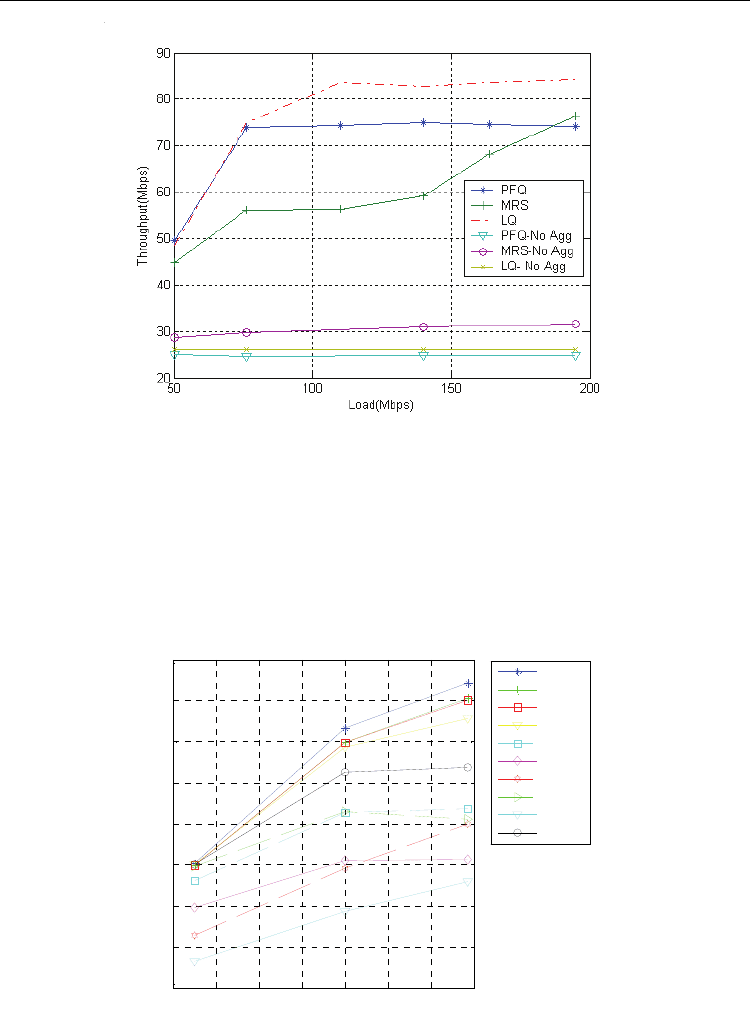
Advances in Greedy Algorithms
402
Fig. 7. Throughput of existing schedulers with and without frame aggregation
AOS/ADOS schemes, since it maximizes the throughput in the long term. Among the
previous schemes, the CQS algorithm provides the highest throughput. This is followed by
OAR and MRS algorithms and the SRPT algorithm exhibits the lowest throughput. In
summary, proposed algorithms AOS, ADOS and P-WF provides the highest throughput as
they possesses the most explicit insight about the system behavior, considering the effects of
the physical medium, MAC efficiency and queue states jointly. It is worthwhile to note that
throughput performance of ADOS is close to AOS, implying that the algorithm can be
applied after rate matching.
60 80 100 120 140 160 180 200
40
50
60
70
80
90
100
110
120
Load(Mbps)
Throughput(Mbps)
P-WF
AOS
ADOS
CQS
OAR-12
OAR-24
MRS
PFQ
SRPT
LQ
Fig. 8. Throughput of proposed and existing schedulers with frame aggregation
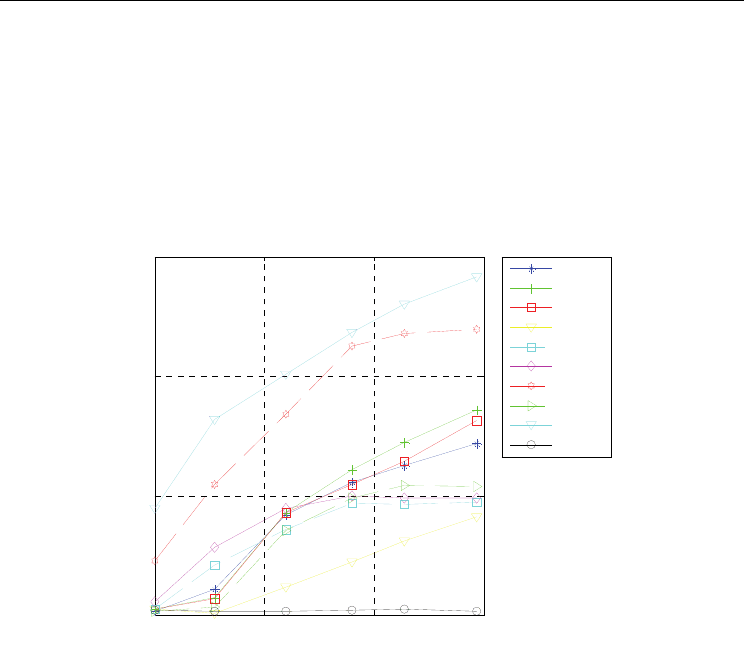
Opportunistic Scheduling for Next Generation Wireless Local Area Networks
403
In order to evaluate fairness, we define an unfairness index as the ratio of the standard
deviation of station throughputs to the mean throughput, i.e., UF = σ / S
av
. It is obvious that
the larger UF gets, the distribution of throughput among stations becomes more unfair.
Using the definition of this unfairness index, a picture of the fairness performance of all
algorithms under varying load has been obtained as depicted in Figure 9. SRPT and MRS
algorithms show the poorest performance in terms of fairness, since they aggressively
favour users with high channel capacities. The LQ algorithm is the fairest scheme as it
operates like the round robin scheme providing equal access to each station. The CQS
algorithm follows the LQ algorithm.
50 100 150 200
0
0.5
1
1.5
Load(Mbps)
Unfairness Index
P-WF
AOS
ADOS
CQS
OAR-12
OAR-24
MRS
PFQ
SRPT
LQ
Fig. 9. Fairness performance under varying load
Fairness of our proposed algorithms remain between CQS and MRS. AOS is the most unfair
among proposed schemes, since instantaneous throughput is maximized, in an
opportunistic fashion. The ADOS algorithm offers slightly more fair distribution than AOS,
due to the fact that quantized data rates results in increased emphasis on queue sizes,
enhancing fairness. Our predictive block scheduler P-WF improves fairness further, since it
considers allocation of multiple users to maximize the long term throughput.
Finally, Figure 10 depicts the MAC efficency of each scheduler, where the actual throughput
and time averaged data rates are plotted together as a function of load, again averaged over
ten toplogies. LQ and CQS algorithms operate with highest eficiencies, where the average
throughput is close to average of physical data rates. SRPT and MRS are the most inefficient
schemes, since the achieved throughput levels half or less than half of the average of
selected user data rates, which are considerably high.
All our proposed algorithms provide a very good compromise between selected physical
layer data rates and efficiency and our predictive block scheduler, P-WF provides the
highest throughput with highest efficiency due to the main objective of long term
throughput maximization.
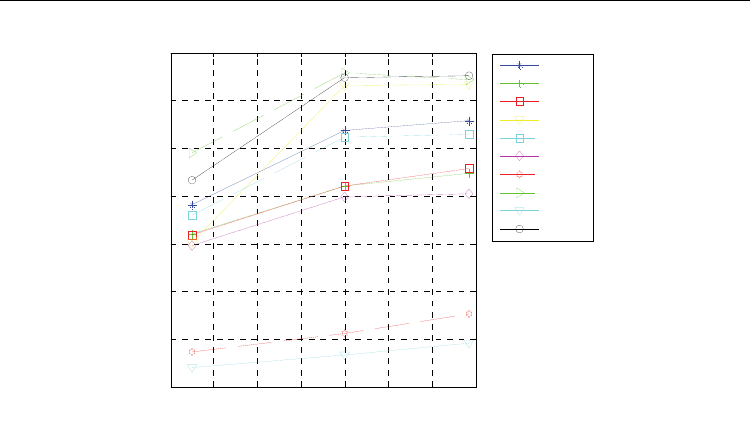
Advances in Greedy Algorithms
404
60 80 100 120 140 160 180 200
0.4
0.5
0.6
0.7
0.8
0.9
1
Load(Mbps)
Throughput(Mbps)/Data Rate(Mbps)
P-WF
AOS
ADOS
CQS
OAR-12
OAR-24
MRS
PFQ
SRPT
LQ
Fig. 10. Average utilization performance
5.2 Performance with relaying
In this section we analyze the effect of incorporating relaying with opportunistic scheduling
and frame aggregation. Distances between the AP and destination stations, the AP and
intermediate stations, and intermediate stations to destination stations define the respective
data rates to be supported in between, so we analyzed relaying by varying the distances
between the stations. Before presenting the results, we first demonstrate how the average
supported data rates vary by the distance.
In Figure 11, for illustration purposes, we present the average physical data rates achieved
for varying distances considering direct transmission and relaying (considering a relay in
the middle), neglecting overhead terms. Relaying does not offer improvement for short
distances since the maximum data rates are already realized by transmitting over one hop.
On the other hand, as distance is increased, the direct transmission rate reduces significantly
and improvement of relaying can be observed.
In our next set of simulations we have considered topologies as shown in an example
configuration in Figure 12 and we have varied the inner radius, d
1
and outer radius, d
2
together, while keeping d
2
/ d
1
= 2. In the figure we show the variation of d
1
only, but the
network radius, d
2
is also varied to keep the same ratio. Accordingly, both the good and bad
positioned stations are effected in a similar manner in terms of the increasing or decreasing
of supported data rates. Yet, the fact that they both increase or decrease does not imply that
their ratio remains fixed, hence the probability of opting for relaying is expected to differ
with varying distance. We again consider a network with 12 stations and one AP. The total
load is set as 200 Mbps, which is evenly distributed between the stations. The algorithms
AOS, CQS and LQ are compared with their counterparts aided by relaying. As explained in
Section 4, the schedulers are applied using the equivalent relaying rate given by Eq. (13) for
a user if it exceeds the rate of direct transmission for that user. The basic rate is selected as
12 Mbps.
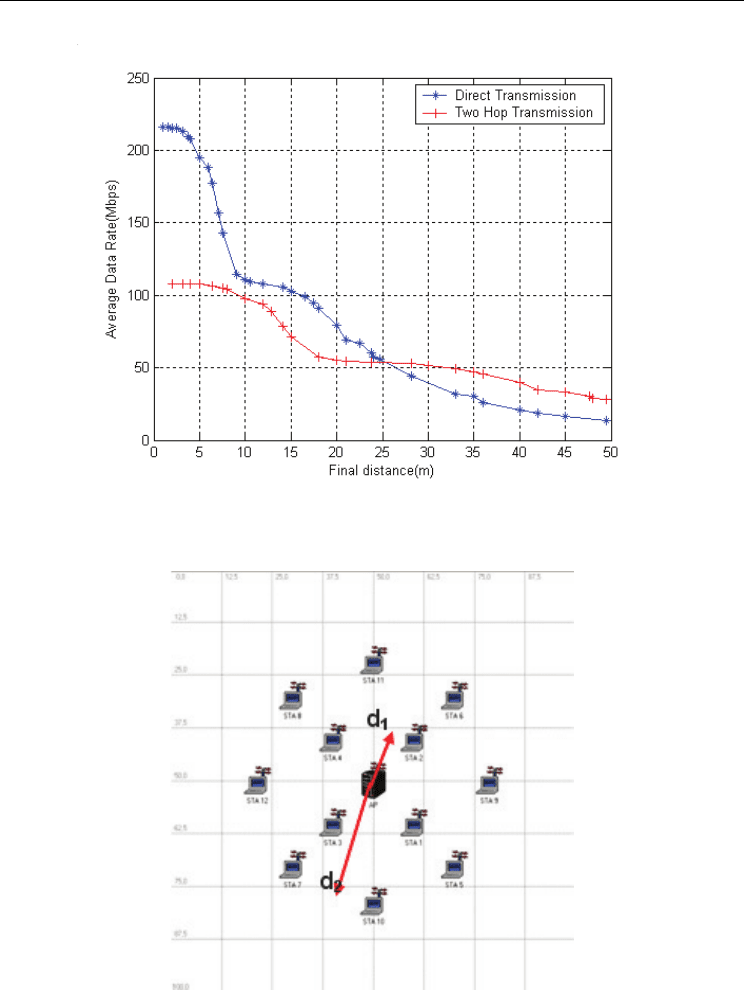
Opportunistic Scheduling for Next Generation Wireless Local Area Networks
405
Fig. 11 Comparison of data rates for direct and two-hop neglecing overhead
Fig. 12 Relaying topology d
2
/d
1
=2

Advances in Greedy Algorithms
406
As depicted in Figure 13, without relaying, the total throughput is decreased as the network
radius is increased, since the supported data rates are likely to decrease for all stations.
When the radius is small, the algorithms perform very similarly, since the topology is close
to a uniform topology. However, the effect of distance on total throughput largely depends
on the scheduling algorithm used. As the network radius is increased, AOS and CQS
outperform LQ since better positioned stations are preferred more frequently. LQ yields
very low throughputs, for the algorithm cannot avoid transmitting to the farther stations,
even if the supported data rates are very low. This result is due to the fact that although LQ
serves each user equally in terms of amount of data, the actual temporal shares of the users
are significantly different. Users with very low transmission rates are served for a very long
duration, reducing total network throughput drastically.
6 8 10 12 14 16 18 20 22 24 26
10
20
30
40
50
60
70
80
90
100
110
d
1
(m)
Throughput(Mbps)
AOS-Rel
CQS-Rel
LQS-Rel
AOS
CQS
LQ
Fig. 13 Throughput with both inner and outer radius varying
As shown in Figure 13, with relaying, the performance of the LQ algorithm is significantly
improved. This is because the effective service rates of the farther stations are increased,
leading to an increase in throughput. For this setting, we observe that the behavior and
performance of the AOS algoritm is not drastically effected by relaying: Initially, all users
are supported with high rates and no relaying is selected. When network radius is
increased, we see that relaying is employed since direct user rates are reduced, and
relaying offers advantage for farther stations. However, as the distance is further
increased, the inner stations start to be scheduled more since their queues grow, resulting
in larger scheduler metrics than the farther stations. Therefore, in AOS, relaying is not
exploited at all for large distances. The behaviour of the CQS algorithm is different than
both LQ and AOS. With CQS, initially relaying offers an improvement for throughput, but
afterwards as the network radius is increased, the increase in the relative proportion of
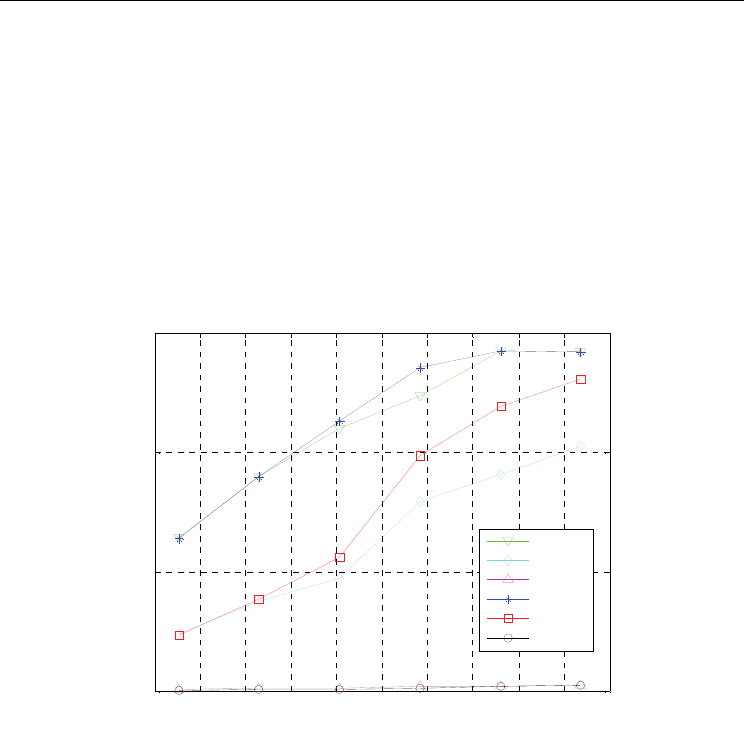
Opportunistic Scheduling for Next Generation Wireless Local Area Networks
407
outer stations being selected results in an overall decrease in the throughput. Therefore,
the frequency of employing relaying in CQS is not as high as LQ, but is still much higher
compared with AOS.
In Figure 14 the unfairness index is plotted as a function of the distance. We see that
relaying yields an increase in the capacity and enables the outer stations to gain access
without growing their queue sizes (as much as the direct case), since their related
scheduling metrics are increased. For AOS, fairness is slightly improved when relaying is
employed, since the outer users are selected more frequently. For the CQS algorithm, we see
that relaying significantly improves fairness preformance since it yields increase in the
capacity terms of outer stations in the scheduling metric, enabling the outer stations to gain
access without having to grow their queue sizes.
6 8 10 12 14 16 18 20 22 24 26
0
0.5
1
1.5
d
1
(m)
Unfairness Index
AOS-Rel
CQS-Rel
LQS-Rel
AOS
CQS
LQ
Fig. 14. Unfairness with both inner and outer radius varying
In essence, applying relaying for IEEE 802.11n improves throughput, fairness or even both
simultanesously, yet the extent of improvement for opportunistic schedulers is limited by
the fact that schedulers tend to give priority to users already with relatively good channel
conditions.
6. Conclusions
In this work, we propose a family of scheduling algorithms for IEEE 802.11n, where
scheduling decisions are based on throughput, calculated instantaously or considering the
long term evolution of user queues. We provide a performance comparison of our
schemes with all outstanding algorithms from the literature considering all in the same air
interface.

Advances in Greedy Algorithms
408
We show that with frame aggregation, spatially greedy scheduling algortihms such as
MRS are no longer optimal for maximizing throughput performance. Even though these
algorithms yield the maximum physical data rates and they would have provided the
highest throughput values in an infinitely backlogged setting if there were no overhead,
they all fail considerably under the 802.11n model. This is because of the fact that the
observed throughput higly depends on the transmission duration as well as the overhead,
especially in WLAN systems which provides improved, 802.11n rates.
Our proposed AOS and ADOS algorithms improve the throughput of such greedy
opportunistic scheems, by up to 53% when aggregation is applied. Our block scheduling
algorithm P-WF further improves the performance, since the statistical evolution of the
queue states are considered and hence the average aggregate size and the throughput are
predicted in the long term, justifying the concept that selecting the user which maximizes
the instantaneous scheduling metric may not provide maximum performance throughout
the entire time duration. This algorithm offers temporal shares of access, in addition to
scheduling order, with allocations that provide maximized long term throughput while at
the same time providing better fairness. When throughput and fairness performance are
considered together, our predictive block scheduler, P-WF stands out as the best scheduling
scheme that provides the highest throughput without fairness penalty.
Applying the concept of relaying is slightly differentiated from convential relaying due to
overhead. We have shown that for networks which have users located far away from the
AP, relaying improves either throughput or fairness or both. Our queue aware scheduler
AOS is not improved through relaying in terms of throughput as much as non-opportunsitic
schedulers since poor channel users are not selected frequently, but yet the performance is
enhanced.
The practical implementation of our scheduling algorithms requires monitoring of the load
at each user queue and the channel conditions. Hence, scheduling decisions can adapt to
varying channel and traffic conditions as long as channel state information and queue states
can be easily, continuously observed.
7. References
Bianchi, G. (2000) . Performance analysis of the IEEE 802.11 distributed coordination
function. IEEE Journal Selected Areas in Communications, 18,3, March 2000, 535 –
547.
Bicket, J.; Aguayo, D. ;Biswas, S. & Morris, R. (2005) Architecture and Evaluation of an
Unplanned 802.11b Mesh Network. MobiCom’05, Cologne, Germany, August
2005
Bolcskei, H.; Gesbert, D. & Paulraj, A. J. (2002). On the Capacity of OFDM-Based Spatial
Multiplexing Systems. IEEE Transactions on Communications, 50, 2, February 2002,
225-234.
Boyer, J.;Falconer, D.D. & Yanikomeroglu, H., (2004). Multihop diversity in wireless
relaying Channels. IEEE Transactions on Communications, 52, 10, October 2004,
1820-1830.

Opportunistic Scheduling for Next Generation Wireless Local Area Networks
409
Ciftcioglu, E.N. & Gurbuz, O. (2006). Opportunistic Scheduling with Frame Aggregation for
Next Generation Wireless LANs. IEEE International Conference on Communications
(ICC) 2006, pp. 5228-5233, Istanbul, Turkey, June 2006.
Ciftcioglu, E.N. & Gurbuz, O. (2007). Access Scheduling Based on Time Water-Filling for
Next Generation Wireless LANs. IEEE Vechicular Technology Conference (VTC)
Spring 2007, pp.2966-2970, Dublin, Ireland, April 2007.
Cover, T.M. & Thomas, J.A. (1991). Elements of Information Theory. Wiley, New York.
Erceg, V. et al. (2004). TGn Channel Models. IEEE 802.11 - 03/940r4, May 2004.
Jalali, A.; Padovani, R. & Pankaj, R. (2000). Data Throughput of CDMA-HDR: A High
Efficiency-High Data Rate Personal Communication Wireless System. Proceedings
of IEEE Vehicular Technology Conference (VTC) Spring 2000, pp. 1854-1858, Tokyo,
Japan, May 2000.
Kleinrock, L. (1975) Queuing Systems, Volume I: Theory. Wiley-Interscience, New York.
Knopp, R. & Humblet, P. (1995). Information capacity and Power Control in Single Cell
Multi-user Communications. Proceedings of IEEEInternational Conference on
Communications (ICC) 1995, pp. 331-335, Seattle, USA. June 1995.
Leon Garcia, A. & Widjaja, I. (2004) Communication Networks: Fundamental Concepts and Key
Architectures. Second Edition, McGraw Hill.
Liu, C. & Stephens, A. P. (2005). An analytic model for infrastructure WLAN capacity with
bidirectional frame aggregation. IEEE Wireless Communications and Networking
Conference (WCNC) 2005, pp. 113-119, New Orleans,, USA, March 2005.
Mujtaba, S.A. (2004). TGn Sync Proposal Technical Specification 3. TGn Sync Technical
Proposal R00, August 13, 2004.
Navda, V.; Kashyap, A. & Das, S. R. (2005) Design and Evaluation of iMesh: an
Infrastructure-mode Wireless Mesh Network. IEEE Symposium on a World of
Wireless, Mobile ans Multimedia(WOWMOM), pp. 164-170, Taormina, Italy, June
2005.
Neely, M.; Modiano, E. & Rohrs, C.(2002) .Power and server allocation in a multi-beam
satellite with time varying channels,” Proceedings of IEEE Infocom 2002, pp. 1451–
1460. New York, USA, June 2002.
Rappaport, T.S. (2002). Wireless Communications: Principles and Practice, Second Edition,
Prentice Hall, Upper Saddle River, NJ.
Sadeghi, B.; Kanodia, V.; Sabharwal, A. & Knightly, E. (2002). Opportunistic Media Access
for Multirate Ad Hoc Networks. Proceedings of ACM MOBICOM 2002, 24-35,
Atlanta, USA, September 2002.
Schrage, L.E. & Miller, L.W. (1966), The queue M/G/1 with the shortest remaining
processing time discipline. Operations Research,14, August 1966, 670-684.
Sreng, V.; Yanikomeroglu, H., & Falconer, D.D. (2002). Coverage enhancement through
two-hop relaying in cellular radio systems. IEEE Wireless Communications and
Networking Conference(WCNC) 2002,
pp. 881-885, Orlando, USA, March 2002.
Telatar, I. E. (1999). Capacity of multi-antenna Gaussian Channels. European Transactions on
Telecommunications, 10, 6, November 1999, 585-595.

Advances in Greedy Algorithms
410
Tinnirello, I. & Choi, S. (2005). Efficiency Analysis of Burst Transmissions with Block ACK in
Contention-Based 802.11e WLANs. Proceedings of IEEE International Conference on
Communications(ICC) 2005, pp. 3455-3460, Seoul, Korea, May 2005.
Zafer, M. & Modiano, E. (2005). A calculus approach to minimum energy transmission
policies with quality of service guarantees. Proceedings of IEEE Infocom 2005, pp.
548-559 , Miami, USA, March 2005
